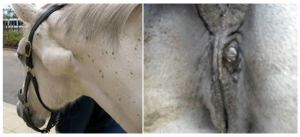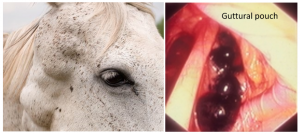Large animal cutaneous neoplasia
Melanomas
Presentation
Melanomas are classically associated with gray horses and are generally black in color, raised and rounded. Many gray horses over the age of 10-12 will have melanomas and 80% will have them by the age of 15. They are found in all age groups of horses; some horses can be born with melanomas. Common sites include the base of the tail and perineal region, the parotid salivary gland and guttural pouch area, the lips/cheeks and the prepuce. Many horses will have multiple melanomas with no related problems. Occasionally melanomas will lead to problems with defecation as they expand in the perineal region. 
The parotid masses can grow quite large but don’t usually impinge on the airway. Parotid melanomas can be seen as black areas on the internal surface of the guttural pouch (making it pretty obvious that resection is unlikely to be an effective or safe measure).

Many melanomas become more aggressive with age and occasionally melanomas become metastatic to other internal organs. We have not yet identified a grading scheme that will let us identify which black melanomas will become problematic; amelanotic melanomas and melanomas on non-gray horses tend to be much more aggressive. Melanomas are rare in other LA species (mini pigs can get them but they can spontaneously regress too).
Treatment
Treatment of melanomas in horses is not currently very effective. Many don’t require treatment. Surgical removal can be difficult as a large expanse of skin and dermis is generally removed, making closure difficult. Oral cimetidine has helped stabilize or regress a few tumors but isn’t very effective and isn’t frequently used. Cisplatin injections and beads, autogenous vaccines and laser therapy have also been used. More recently, interleukins, frankincense injections and the canine melanoma vaccine have been trialed but efficacy results have not been published. Imiquimod may be effective but has yet to be proven. If removal is indicated, we will usually start with laser debulking, followed by cisplatin beads or chemotherapeutic injections. Microwave ablation techniques may be helpful for tumors that are causing issues.
Key Takeaways
Equine melanomas are common in gray horses, particularly in the parotid region, mouth/lips and under the tail. Many adult horses are affected- not just old horses.
- Black tumor on a gray horse = melanoma
- We don’t know how best to treat them. Many will never need treatment.
- We also don’t know how to figure out which will become problems. Biopsies do not help in staging.
Resources
Treatment Options for Melanoma of Gray Horses, VCNA Vol.35(2), pp.311-325, 2019
Melanoma in horses: Current perspectives, EVE Vol.25(3), pp.144-151, 2013
Equine Melanocytic Tumors, VCNA Vol.29(3), pp.673-687, 2013
Integumentary disorders including cutaneous neoplasia in older horses. VCNA 32:263-281, 2016
Researchers Study Plant-Based Treatment for Equine Melanoma, The Horse 2016
surgical removal of as much of tumor as possible

